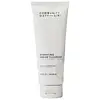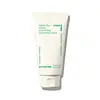What's inside
What's inside
 Key Ingredients
Key Ingredients

 Benefits
Benefits

 Concerns
Concerns

 Ingredients Side-by-side
Ingredients Side-by-side

Ethylhexyl Palmitate
EmollientWater
Skin ConditioningCaprylic/Capric Triglyceride
MaskingPrunus Amygdalus Dulcis Oil
Skin ConditioningEuphorbia Cerifera Wax
Stearic Acid
CleansingCopernicia Cerifera Wax
Glyceryl Stearate Se
EmulsifyingTromethamine
BufferingIsostearic Acid
CleansingAvena Sativa Kernel Flour
AbrasiveLecithin
EmollientDisteardimonium Hectorite
StabilisingMagnesium Aluminum Silicate
AbsorbentCoco-Caprylate/Caprate
EmollientSodium Lauroyl Sarcosinate
CleansingSorbitan Stearate
EmulsifyingKaolin
AbrasiveSaccharomyces Ferment
Skin ConditioningTriheptanoin
Skin ConditioningDecyl Glucoside
CleansingC9-12 Alkane
SolventPolyurethane-10
1,2-Hexanediol
Skin ConditioningSodium Benzoate
MaskingCaprylyl Glycol
EmollientAllantoin
Skin ConditioningTocopheryl Acetate
AntioxidantIsohexadecane
EmollientButylene Glycol
HumectantLauroyl Lysine
Skin ConditioningLauryl Glucoside
CleansingSorbitan Oleate
EmulsifyingCitric Acid
BufferingAloe Barbadensis Leaf Juice
Skin ConditioningHydroxyacetophenone
AntioxidantSodium Hyaluronate
HumectantHippophae Rhamnoides Fruit Extract
Skin ConditioningPanthenol
Skin ConditioningAnthemis Nobilis Flower Extract
MaskingCamellia Sinensis Leaf Extract
AntimicrobialEucalyptus Globulus Leaf Extract
PerfumingLavandula Angustifolia Flower/Leaf/Stem Extract
MaskingMentha Viridis Extract
MaskingPogostemon Cablin Leaf Extract
PerfumingRose Extract
Skin ConditioningQuartz
AbrasiveZingiber Officinale Extract
Skin ConditioningCurcuma Longa Root Extract
MaskingEthylhexyl Palmitate, Water, Caprylic/Capric Triglyceride, Prunus Amygdalus Dulcis Oil, Euphorbia Cerifera Wax, Stearic Acid, Copernicia Cerifera Wax, Glyceryl Stearate Se, Tromethamine, Isostearic Acid, Avena Sativa Kernel Flour, Lecithin, Disteardimonium Hectorite, Magnesium Aluminum Silicate, Coco-Caprylate/Caprate, Sodium Lauroyl Sarcosinate, Sorbitan Stearate, Kaolin, Saccharomyces Ferment, Triheptanoin, Decyl Glucoside, C9-12 Alkane, Polyurethane-10, 1,2-Hexanediol, Sodium Benzoate, Caprylyl Glycol, Allantoin, Tocopheryl Acetate, Isohexadecane, Butylene Glycol, Lauroyl Lysine, Lauryl Glucoside, Sorbitan Oleate, Citric Acid, Aloe Barbadensis Leaf Juice, Hydroxyacetophenone, Sodium Hyaluronate, Hippophae Rhamnoides Fruit Extract, Panthenol, Anthemis Nobilis Flower Extract, Camellia Sinensis Leaf Extract, Eucalyptus Globulus Leaf Extract, Lavandula Angustifolia Flower/Leaf/Stem Extract, Mentha Viridis Extract, Pogostemon Cablin Leaf Extract, Rose Extract, Quartz, Zingiber Officinale Extract, Curcuma Longa Root Extract
Water
Skin ConditioningGlycerin
HumectantMyristic Acid
CleansingLauric Acid
CleansingPotassium Hydroxide
BufferingStearic Acid
CleansingGlyceryl Stearate
EmollientGlycol Distearate
EmollientPalmitic Acid
EmollientLauryl Hydroxysultaine
CleansingPolyquaternium-22
Lauryl Glucoside
CleansingPropanediol
SolventParfum
MaskingPotassium Cocoyl Glycinate
1,2-Hexanediol
Skin ConditioningHydrolyzed Corn Starch
HumectantPinus Densiflora Leaf Extract
AntimicrobialDisodium EDTA
Butylene Glycol
HumectantArginine
MaskingAspartic Acid
MaskingGlutamic Acid
HumectantEthylhexylglycerin
Skin ConditioningCamellia Sinensis Leaf Extract
AntimicrobialAcrylates/Stearyl Methacrylate Copolymer
Emulsion StabilisingTremella Fuciformis Sporocarp Extract
AntioxidantTetrasodium EDTA
Hyaluronic Acid
HumectantXanthan Gum
EmulsifyingCeramide NP
Skin ConditioningAcorus Calamus Root Extract
PerfumingWater, Glycerin, Myristic Acid, Lauric Acid, Potassium Hydroxide, Stearic Acid, Glyceryl Stearate, Glycol Distearate, Palmitic Acid, Lauryl Hydroxysultaine, Polyquaternium-22, Lauryl Glucoside, Propanediol, Parfum, Potassium Cocoyl Glycinate, 1,2-Hexanediol, Hydrolyzed Corn Starch, Pinus Densiflora Leaf Extract, Disodium EDTA, Butylene Glycol, Arginine, Aspartic Acid, Glutamic Acid, Ethylhexylglycerin, Camellia Sinensis Leaf Extract, Acrylates/Stearyl Methacrylate Copolymer, Tremella Fuciformis Sporocarp Extract, Tetrasodium EDTA, Hyaluronic Acid, Xanthan Gum, Ceramide NP, Acorus Calamus Root Extract
 Reviews
Reviews

Alternatives
Ingredients Explained
These ingredients are found in both products.
Ingredients higher up in an ingredient list are typically present in a larger amount.
1,2-Hexanediol is a synthetic liquid and another multi-functional powerhouse.
It is a:
- Humectant, drawing moisture into the skin
- Emollient, helping to soften skin
- Solvent, dispersing and stabilizing formulas
- Preservative booster, enhancing the antimicrobial activity of other preservatives
Butylene Glycol (or BG) is used within cosmetic products for a few different reasons:
Overall, Butylene Glycol is a safe and well-rounded ingredient that works well with other ingredients.
Though this ingredient works well with most skin types, some people with sensitive skin may experience a reaction such as allergic rashes, closed comedones, or itchiness.
Learn more about Butylene GlycolCamellia Sinensis Leaf Extract is derived from the leaves of the tea plant. Black tea, green tea, and oolong tea are all harvested from this plant.
This ingredient has many skin benefits:
This ingredient contains polyphenols, a strong antioxidant. Antioxidants help fight off molecules that damage skin cells.
On top of that, the antioxidants in green tea neutralize free-radicals from the sun. This gives the skin some extra UV protection, but should not replace sunscreen.
Many components of tea have anti-inflammatory properties.
Polyphenols and L-theanine help soothe the skin and reduce irritation. The caffeine in Camellia Sinensis Leaf Extract helps calm inflamed blood vessels.
Other compounds found in tea include: Vitamin Bs, linoleic acid, magnesium, calcium, iron, and zinc.
Research has shown both drinking Camellia Sinensis Leaf Tea and applying it to the skin can help boost skin elasticity and hydration. Studies also show using tea extract may reduce sebum, or oil, production.
Learn more about Camellia Sinensis Leaf ExtractLauryl Glucoside sugar- and lipid-based cleansing agent. It is created from glucose and lauryl alcohol.
This ingredient is a surfactant, making it easier to rinse oil, dirt, and other pollutants away.
A British study found lauryl glucoside to cause skin sensitivity for some people. We recommend speaking with a professional if you have concerns.
Other names for this ingredient include "Lauryl Polyglucose", "Lauryl glycoside", and "D-Glucopyranoside".
Learn more about Lauryl GlucosideStearic Acid is a fatty acid. It is an emollient, emulsifier, and texture enhancer.
As an emollient, stearic acid helps soften skin. It aids the skin's protective barrier by preventing water loss. It also provides a gentle cleansing effect without stripping away natural oils.
Stearic acid may also be used to enhance the texture of products. It can add volume and stabilize ingredients such as water and oil. This can help water and oil ingredients from separating.
Sources of stearic acid include animal or vegetable fats/oils such as coconut or shea. It can be naturally found in butter, cocoa butter, shea butter, vegetable fats, and animal tallow.
This ingredient may not be Malassezia folliculitis, or fungal-acne safe.
Learn more about Stearic AcidWater. It's the most common cosmetic ingredient of all. You'll usually see it at the top of ingredient lists, meaning that it makes up the largest part of the product.
So why is it so popular? Water most often acts as a solvent - this means that it helps dissolve other ingredients into the formulation.
You'll also recognize water as that liquid we all need to stay alive. If you see this, drink a glass of water. Stay hydrated!
Learn more about Water